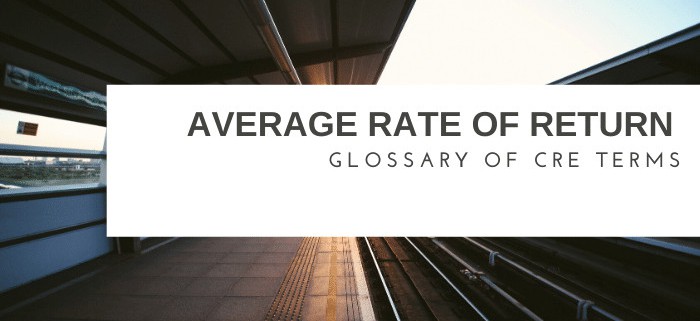Average Rate of Return
A measure of the profitability of a real estate investment or a type of return metric. The average rate of return is calculated as the total net profit of an investment (total cash inflows minus total cash outflows), divided by the length of the investment, divided by the invested capital. The main drawback of this return metric is that it does not take into account the time value of money.
Average Rate of Return = Total Net Profit ÷ Investment Period ÷ Equity Contributed
Example:
An investor purchases a retail center for $1,000 in cash. The investor holds the center for 10 years, during which the investment earns $100 each year in rental income. At the end of the 10-year period, the investor sells the property for $1,500. To calculate the average rate of return (ARR), follow these steps:
- Annual Earnings:
- The investment earns $100 each year for 10 years.
- Total earnings over 10 years: $100 × 10 = $1,000
- Capital Gain:
- Initial purchase price: $1,000
- Sale price after 10 years: $1,500
- Capital gain from the sale: $1,500 – $1,000 = $500
- Total Net Profit:
- Total annual earnings: $1,000
- Capital gain: $500
- Total net profit: $1,000 + $500 = $1,500
- Calculate Average Rate of Return (ARR):
- Total net profit: $1,500
- Investment period: 10 years
- Initial investment (equity contributed): $1,000
- Formula: ARR = Total Net Profit ÷ Investment Period ÷ Equity Contributed
- Calculation: ARR = $1,500 ÷ 10 years ÷ $1,000
- Step-by-step Calculation:
- First, divide the total net profit by the investment period: $1,500 ÷ 10 years = $150
- Then, divide the result by the equity contributed: $150 ÷ $1,000 = 0.15 or 15%
Result: The average rate of return for this investment is 15%.
Putting ‘Average Rate of Return’ in Context
Scenario Overview
Lloyd Martinez, a senior engineer at a large aerospace firm, invests in commercial real estate on the side to bolster his retirement. He has identified an opportunity to purchase Peachtree Village Shopping Center, a neighborhood shopping center located in suburban Atlanta, Georgia. The center, which is a well-maintained property with a mix of retail tenants, presents a chance for Lloyd to achieve stable income with some potential for value appreciation.
Property and Investment Details
- Property: Peachtree Village Shopping Center
- Location: Suburban Atlanta, Georgia
- Purchase Price: $5,000,000
- Equity Contributed: $5,000,000 (all-cash purchase)
- Investment Holding Period: 7 years
- Effective Gross Revenue: $450,000 annually
- Operating Expenses: $100,000 annually
- Net Operating Income (NOI): $350,000 annually ($450,000 – $100,000)
- Sale Price after 7 Years: $6,500,000
Calculating the Average Rate of Return
Annual Earnings
Over the 7-year holding period, the shopping center generates an annual net operating income (NOI) of $350,000. Therefore, the total NOI over the investment period is:
Total NOI: $350,000 × 7 = $2,450,000
Capital Gain
The capital gain from the sale of the property is calculated as follows:
Capital gain: Sale price – Purchase price = $6,500,000 – $5,000,000 = $1,500,000
Total Net Profit
Combining the total NOI and the capital gain, the total net profit is:
Total net profit: $2,450,000 + $1,500,000 = $3,950,000
Average Rate of Return (ARR)
To calculate the ARR, we use the formula:
ARR = Total Net Profit ÷ Investment Period ÷ Equity Contributed
Plugging in the values:
ARR = $3,950,000 ÷ 7 years ÷ $5,000,000
Breaking it down step-by-step:
- Divide the total net profit by the investment period:
$3,950,000 ÷ 7 years = $564,285.71 - Then, divide the result by the equity contributed:
$564,285.71 ÷ $5,000,000 = 0.1129 or 11.29%
Result
The average rate of return for Lloyd Martinez’s investment in Peachtree Village Shopping Center is 11.29%.
Conclusion
This hypothetical scenario illustrates the calculation and application of the average rate of return in a core-plus acquisition investment. The ARR provides a straightforward measure of profitability over the investment period, but it does not account for the time value of money. Investors like Lloyd must consider this limitation when using ARR to evaluate investment performance.
Frequently Asked Questions about Average Rate of Return in Commercial Real Estate
What is the Average Rate of Return (ARR)?
ARR is a profitability metric calculated as total net profit divided by the investment period and then divided by equity contributed. It does not account for the time value of money.
How do you calculate Average Rate of Return?
Use the formula:
ARR = Total Net Profit ÷ Investment Period ÷ Equity Contributed
Where net profit includes both income during the hold and any capital gain from sale.
What was the ARR in the Peachtree Village Shopping Center example?
Lloyd Martinez’s all-cash investment earned $3,950,000 over 7 years on $5,000,000 invested.
ARR = $3,950,000 ÷ 7 ÷ $5,000,000 = 11.29%
What is a key limitation of ARR?
ARR does not account for the time value of money, meaning it treats all cash flows equally regardless of when they occur.
How is ARR different from IRR?
ARR is a simple average that ignores timing, while IRR incorporates the time value of money and measures the rate that equates discounted cash flows to the investment cost.
Why might an investor still use ARR?
ARR is easy to calculate and provides a quick snapshot of investment profitability, especially useful when comparing multiple projects with similar timelines.
Click here to get this CRE Glossary in an eBook (PDF) format.

